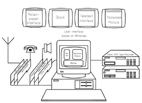 Figure 1: Distribution system for electronic news, an example using a TV-transmission system.
Figure 1: Distribution system for electronic news, an example using a TV-transmission system.

by Nils Kristian Rossing
Today there are more than 80.000 people with blindness or reduced sight in Norway, and there are even more people suffering from dyslexia. A brief estimation is that 150.000 adults have serious problems in reading newspapers. Since the main news sources are radio, television, teletext, newspapers and magazines these two groups of people have problems to acquire news.
People with dyslexia have the advantage of television but have problems reading the subtitles used for translation of foreign languages. Both groups have problems reading the teletext, as well as newspapers and magazines. Many persons with dyslexia can, however, read the headlines.
In the periode from 1987 to 1994 students at the Norwegian Institute of Technology have worked on subjects related to the reading impaired, for a total of more than 7000 hours. Our goal has been to develop a news centre for visually impaired and people with dyslexia. As personal computers have become cheaper and increasingly powerful, we have chosen the PC as a platform for our development.
The transmission systems
In order to bring the information to the user group, we can choose among different transmission media. The television transmission system has several advantages:
Our intention is also to develop a NICAM decoder card. NICAM is the modern digital sound channel used in combination with the PAL television system. NICAM can handle data rates up to about 700 kbit/sec.
Another alternative is to use the telephone network. Modems are available with typical transfer rates from 1200 to 14800 bauds. The disadvantage is that the ordinary telephone network only can handle one subscriber at a time. Data pack can, however, handle several subscribers but are rather expensive. The ISDN net has been available all over Norway from May 1994. Presently the price for a subscription is about 3 - 4 times that of an ordinary telephone. ISDN is offering 2 * 64 kbit channels as the normal subscription, called basic rate subscription.
The user interface
At NTH/DELAB user interfaces for teletext have been developed for visually impaired and for people with dyslexia. The interface for dyslexia uses window menus, icons1 and speech synthesis, while the interface for the visual impaired uses speech synthesis combined with a braille display. Both interfaces are prepared for speech synthesis of subtitling of programs with foreign languages using the teletext channel.
This autumn we are working with a newspaper interface for people with dyslexia. In 1993-94 software converting the typical Norwegian newspaper format, Nordtext, to the transfer format EIF (European Interchange Format) was developed. EIF is an DTD (Document Type Definition) in the SGML (Standard Generalized Mark-up Language) document format.
Data storage
The main storage is the harddisk. A newspaper with pictures (for people with dyslexia) requires about 10 Mbyte of storage space. A newspaper without pictures (visually impaired) requires from 0.5 - 1 Mbyte. Normally "old copies" will be discarded. However, an ordinary Video Tape Recorder is a very powerful storage. It can store between 0.5 - 1 Gbyte per 1 hour tape. Such a recorder is also quite cheap and is already available in many homes. For that reason we have studied the ability to prepare PC-data for the video tape recorder. Powerful error correcting codes are important.
The speech synthesizer
The speech synthesizer technique in common use to day is the phoneme synthesis. This method combines about 40 phonemes (sounds) to words. A better solution is to use diphone synthesis. This method combines two adjacent phonemes into diphones. In the Norwegian language about 1500 diphones are needed to get the total amount of words. This last method gives a better pronunciation than the phoneme synthesis, but requires much more computer power. Using a signal processing PC-card it has been possible to handle ASCII-text in "real time" with the diphone speech synthesis technique. This technique has been used together with the teletext interface.
Braille Mouse
Together with the speech synthesis the 80 element Braille Display can be a good substitute for the screen for the blind and visually impaired. Such displays are, however, rather expensive. In 1990 we developed a reading and pointing "Mouse" with two 8 pin Braille elements.
Moving the mouse back and forth on the table, the user could scan the screen. Each letter on the screen would pop up under the user's finger-tips as a Braille sign. With buttons on the mouse, it is possible to control the speech synthesizer. This mouse could for example be used together with the editing program Word Perfect.
Application examples Electronic transmission of News: By using the Packet 31 data channel for newspaper distribution a subscriber with a television set, a computer and a combined packet 31 and teletext decoder card have lots of information available. You can have an electronic newspaper, teletext and television with sound. In addition it is possible to get a speech synthesis of the subtitling of programs in foreign languages.
 Figure 1: Distribution system for electronic news, an example using a TV-transmission system.
Figure 1: Distribution system for electronic news, an example using a TV-transmission system.
 Figure 2: Subscriber unit for people with dyslexia.
Figure 2: Subscriber unit for people with dyslexia.
People with dyslexia usually have large problems reading the subtitles on the television screen. In summer 1994 a Demonstration Model was developed for the Norwegian Broadcasting Corporation (NRK). A special teletext interface for people with dyslexia using diphone speech synthesis was demonstrated together with speech synthesis of subtitling.
All this work has been done on an experimental basis and with very little economical risk. We hope that some parts of this work can be realised as a product in the future. To make this possible we need an industrial partner who knows the market and has the technology and economy necessary to develop a prototype to an industrial product.